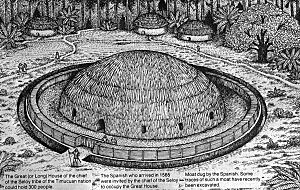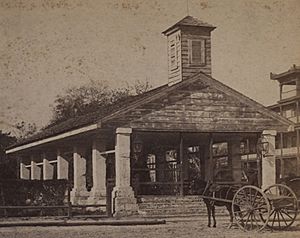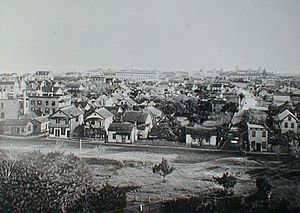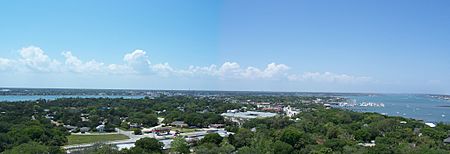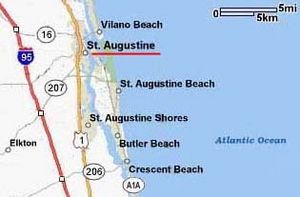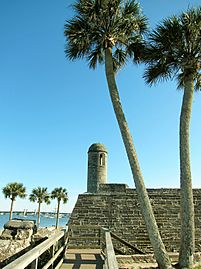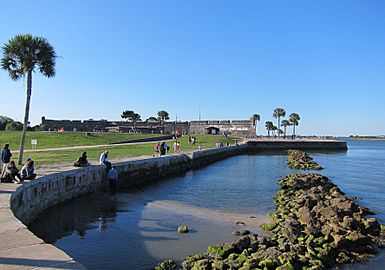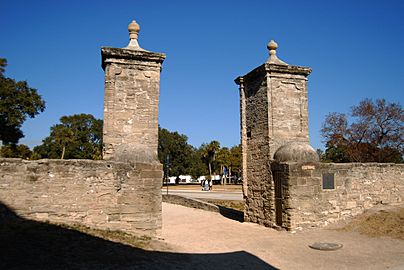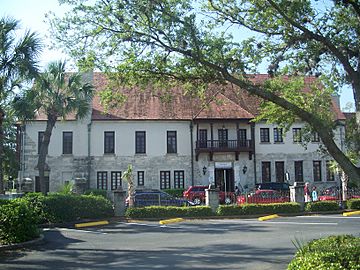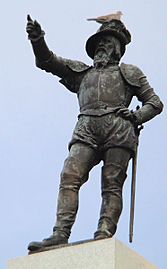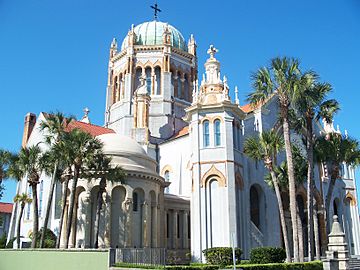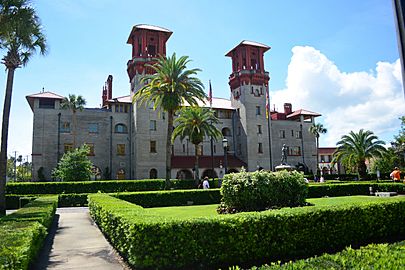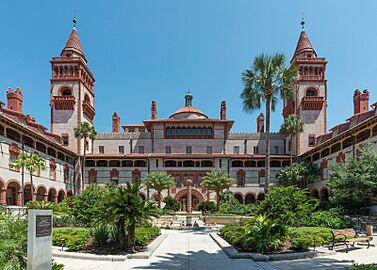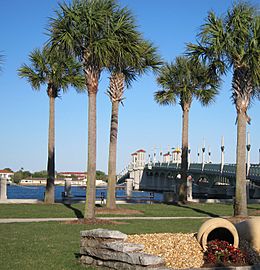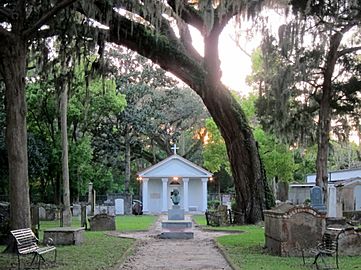St. Augustine, Florida facts for kids
Quick facts for kids
St. Augustine
San Agustín (Spanish)
|
||
|---|---|---|
| City of St. Augustine | ||

Top, left to right: Castillo de San Marcos, St. Augustine Light, Flagler College, Lightner Museum, statue near the Cathedral Basilica of St. Augustine, St. Augustine Alligator Farm Zoological Park, Old St. Johns County Jail
|
||
|
||
| Nickname(s):
Ancient City, Old City
|
||
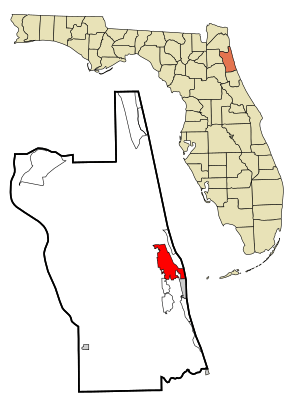
Location in St. Johns County and the U.S. state of Florida
|
||
| Country | United States | |
| State | Florida | |
| County | St. Johns | |
| Established | September 8, 1565 | |
| Founded by | Pedro Menéndez de Avilés | |
| Named for | Saint Augustine of Hippo | |
| Government | ||
| • Type | Commissioner-Manager | |
| Area | ||
| • City | 12.85 sq mi (33.29 km2) | |
| • Land | 9.52 sq mi (24.66 km2) | |
| • Water | 3.33 sq mi (8.63 km2) | |
| Elevation | 0 ft (0 m) | |
| Population
(2020)
|
||
| • City | 14,329 | |
| • Density | 1,504.99/sq mi (581.05/km2) | |
| • Urban | 91,786 | |
| Time zone | UTC−5 (EST) | |
| • Summer (DST) | UTC−4 (EDT) | |
| ZIP code(s) |
32080, 32084, 32085, 32086, 32095, 32082, 32092
|
|
| Area code(s) | 904, 324 | |
| FIPS code | 12-62500 | |
| GNIS feature ID | 0308101 | |
| Website | City of St. Augustine | |
St. Augustine is a city in Florida, located on the Atlantic coast. It is about 40 miles (64 km) south of Jacksonville. Spanish settlers founded the city in 1565. This makes it the oldest continuously lived-in European settlement in what is now the contiguous United States.
St. Augustine was founded on September 8, 1565, by Pedro Menéndez de Avilés. He was a Spanish admiral and Florida's first colonial governor. He named the settlement San Agustín (Saint Augustine). His ships first saw land on August 28, which was the feast day of St. Augustine. The city was the capital of Spanish Florida for over 200 years. It also served as the capital of British East Florida from 1763 to 1783.
Spain gave Florida to the United States in 1819. St. Augustine became one of two alternating capitals of the Florida Territory. The other was Pensacola. In 1824, Tallahassee became the permanent capital.
St. Augustine is part of Florida's First Coast region. It had about 14,329 people in 2020. Since the late 1800s, its unique history has made it a popular tourist spot. The Castillo de San Marcos, a 17th-century Spanish fort, is a big attraction. St. George Street is a main walking street downtown. It has many historic houses and attractions.
Contents
- History of St. Augustine
- Early European Exploration
- How Pedro Menéndez de Avilés Founded the City
- Attacks by Pirates and Enemies
- British Rule and Loyalists
- Second Spanish Period
- Florida Becomes a U.S. Territory
- St. Augustine During the Civil War
- Henry Flagler and the Railroad
- Civil Rights Movement in St. Augustine
- Modern St. Augustine
- Geography and Climate
- People of St. Augustine
- Getting Around St. Augustine
- Places to Visit
- Culture
- Education
- Images for kids
- Famous People from St. Augustine
- Sister Cities
- Gallery
- See also
History of St. Augustine
St. Augustine has a long and interesting history. It has been under the control of different countries over the centuries.
Early European Exploration
The first European to explore the Florida coast was Juan Ponce de León in 1513. He was a Spanish explorer and governor of Puerto Rico. He likely explored near where St. Augustine is today. He named the land "La Florida" and claimed it for Spain.
How Pedro Menéndez de Avilés Founded the City
Pedro Menéndez de Avilés founded St. Augustine in 1565. It is the oldest settlement of European origin in the United States that has been continuously lived in. Only San Juan, Puerto Rico (founded in 1521) is older in U.S. territory.
In the 1560s, King Philip II of Spain asked Menéndez to lead an expedition to Florida. His mission was to explore and settle the area. He also needed to remove the French, who were seen as a threat.
Menéndez raced to Florida before the French captain Jean Ribault. On August 28, 1565, Menéndez's crew saw land. They sailed north, looking at every inlet. On September 4, they met four French ships near the St. Johns River. There was a small fight, but no clear winner.
Menéndez sailed south and landed on September 8. He officially claimed the land for King Philip II. He named the settlement San Agustín. The expedition's chaplain, Father Francisco López, held the first Thanksgiving Mass. The Mission Nombre de Dios was founded at this spot.
The settlement was built in the former village of Seloy. This was a Timucua village. The location was good for defense and water travel.
A storm stopped a French attack on St. Augustine. Menéndez then marched his troops to Fort Caroline, a French fort about 30 miles (48 km) north. The Spanish easily took over the fort, killing most of the French soldiers. Menéndez renamed it San Mateo.
Later, Menéndez found shipwrecked French survivors south of St. Augustine. He accepted their surrender. However, he then executed most of them, except for a few Catholics and skilled workers. This event happened at what is now Matanzas Inlet. Matanzas means "slaughters" in Spanish. The Fort Matanzas national monument was built nearby later.
Attacks by Pirates and Enemies
Early governors tried to live peacefully with the local Native Americans. This gave St. Augustine some peace. But in 1586, the English privateer Sir Francis Drake attacked and burned St. Augustine. The townspeople had to leave. Drake's men took artillery and gold. They burned the town after a Spanish soldier killed one of their men.
In the late 1600s, Native American groups from the Carolina colony raided Florida. They killed Franciscan priests at the Catholic missions. Spanish leaders asked for stronger defenses for St. Augustine, but the king did not send help.
The English buccaneer Robert Searle attacked St. Augustine in 1668. He killed 60 people and robbed stores and churches. This raid, and the founding of Charles Town by the English, made Spain realize St. Augustine needed better defenses. In 1669, Queen Mariana ordered money for a strong stone fort.
Construction of the Castillo de San Marcos began in 1672. It was finished in 1695. Soon after, in 1702, forces from Carolina led by James Moore attacked. They could not capture the fort. As they left, the British burned St. Augustine.
In 1738, the Spanish governor, Manuel de Montiano, ordered a settlement for Free Black people. These were enslaved people who had escaped from the Thirteen Colonies into Florida. This new community, Fort Mose, was two miles north of St. Augustine. It served as a military outpost and protected the city. The men there joined the colonial militia and became Catholic in exchange for their freedom.
In 1740, St. Augustine was attacked again. This time, it was by General James Oglethorpe from the British colony of Georgia. He also failed to take the fort.
British Rule and Loyalists
The 1763 Treaty of Paris ended the Seven Years' War. Great Britain won and gained Florida from Spain. Most Spanish colonists left Florida for Cuba. Florida became a British colony. St. Augustine became a safe place for Loyalists during the American Revolutionary War.
Britain wanted to repopulate Florida. They offered large plots of land to groups who would settle there. Under Governor James Grant, many acres were given out. New houses were built, and farming began to grow.
During 20 years of British rule, Britain controlled the Castillo de San Marcos (renamed Fort St. Mark) and Fort Matanzas. Fort St. Mark became a training base and a prisoner-of-war camp. Some signers of the Declaration of Independence were held there.
The 1783 Treaty of Paris ended the American Revolution. It gave Florida back to Spain. Some Spanish residents returned to St. Augustine. Many settlers from a troubled colony in New Smyrna had moved to St. Augustine in 1777. They stayed when Spain took control again. These people are still called "Menorcans" locally. This group also included settlers from Italy, Corsica, and the Greek islands.
Second Spanish Period
During the Second Spanish period (1784–1821), Spain was busy with wars in Europe. They struggled to control their lands in the Americas. Florida was seen as not very important. However, the United States wanted Florida for its own growth.
A hurricane hit St. Augustine in 1811, causing much damage. The Adams–Onís Treaty in 1819 gave Florida and St. Augustine to the United States.
Florida Becomes a U.S. Territory
After the treaty, Andrew Jackson set up a new government in Florida. Americans from older states like Virginia and Georgia began to move to the area. The new capital of Florida became Tallahassee in 1824.
As more Americans moved in, conflicts with local Creek and Miccosukee people grew. The U.S. government wanted to move Native Americans. But Florida's native groups refused to leave without a fight. The 1800s saw three Seminole Wars.
In 1823, the Treaty of Moultrie Creek forced Seminoles onto a reservation. The Second Seminole War (1835–1842) was the longest war of Indian removal. During this war, Seminole prisoners, including the leader Osceola, were held in the Castillo de San Marcos. It was renamed Fort Marion.
By 1840, Florida's population was 54,477. Half of these people were enslaved Africans. In 1845, Florida became a state.
St. Augustine During the Civil War
On January 7, 1861, Florida left the Union to join the Confederacy. A group of Florida militia marched on Fort Marion. The fort was guarded by one sergeant, who surrendered it. General Robert E. Lee ordered the fort's cannons moved to other places.
The town formed a Confederate militia unit. The Confederate government ordered all lighthouses to be put out. In St. Augustine, Paul Arnau organized a group to disable lighthouses along Florida's east coast. They removed the lenses from the St. Augustine Light. Arnau then served as mayor.
Confederate forces controlled St. Augustine for 14 months. The Union blocked shipping. In 1862, Union troops took control of St. Augustine. They held it for the rest of the war. Many residents left because the economy was suffering.
Henry Flagler and the Railroad
Henry Flagler, a co-founder of Standard Oil Company, visited St. Augustine in 1883. He liked the city but thought its hotels and transport were not good enough. He wanted to make St. Augustine a winter resort for rich Americans. To do this, he bought several small railroads. In 1885, he combined them to form the Florida East Coast Railway. In 1888, he built a railroad bridge over the St. Johns River. This opened up Florida's Atlantic coast for development.
Flagler built two large, fancy hotels: the 450-room Hotel Ponce de Leon and the 250-room Hotel Alcazar. He also bought the Casa Monica Hotel. His architects changed the look of St. Augustine with these hotels. They used Spanish Renaissance Revival and Moorish Revival styles. When the Ponce de Leon opened in 1888, St. Augustine became a popular winter resort for high society.
Later, Flagler's railroad extended south to Palm Beach and Miami. Wealthy travelers then went further south for warmer weather. But St. Augustine still attracted tourists. It became a popular spot for families traveling by car. Tourism soon became the main part of the local economy.
Civil Rights Movement in St. Augustine
In 1963, African Americans in St. Augustine were still fighting to end segregation in schools and public places. This was almost ten years after the Supreme Court ruled segregation illegal. Local students held protests like sit-ins and marches. Police often responded with violence. Homes were firebombed, and black leaders were attacked.
In 1964, local civil rights leader Robert Hayling asked Martin Luther King Jr. and the Southern Christian Leadership Conference (SCLC) for help. From May to July 1964, King, Hayling, and others organized marches and sit-ins. Hundreds of civil rights supporters were arrested.
St. Augustine was the only place in Florida where King was arrested. This happened on June 11, 1964, at the Monson Motor Lodge. The protests reached a peak when black and white protesters jumped into the hotel's segregated swimming pool. The hotel manager, James Brock, poured acid into the pool to scare them. Photos of this were shown worldwide. One photo was on the front page of a Washington paper the day the Senate voted on the Civil Rights Act of 1964. It became a very famous photo from St. Augustine.
The Ku Klux Klan and their supporters reacted with violent attacks. These were widely reported. Public outrage against the Klan and police violence helped lead to the passage of the Civil Rights Act of 1964. This act, and later the Voting Rights Act of 1965, helped protect constitutional rights.
St. Augustine's historically Black college, now Florida Memorial University, moved away in 1968. It felt unwelcome in the city.
Modern St. Augustine
In 1965, St. Augustine celebrated its 400th anniversary. A program began to restore parts of the colonial city. The Historic St. Augustine Preservation Board rebuilt over 36 buildings to look as they did historically. In 2010, the city transferred control of these buildings to University of Florida Historic St. Augustine, Inc..
Cross and Sword was a play created in 1965 to honor the city's founding. It was Florida's official state play and was performed for over 30 years.
In 2015, St. Augustine celebrated its 450th anniversary. The King and Queen of Spain visited for the event.
On October 7, 2016, Hurricane Matthew caused widespread flooding in downtown St. Augustine.
Geography and Climate
St. Augustine is located at 29°53′41″N 81°18′52″W / 29.89472°N 81.31444°W. The city has a total area of about 10.7 square miles (27.8 km2). About 8.4 square miles (21.7 km2) is land, and 2.4 square miles (6.1 km2) is water. You can reach the Atlantic Ocean through the St. Augustine Inlet of the Matanzas River.
St. Augustine has a humid subtropical climate. This means it's usually warm and sunny. The driest time of year is winter. The hot and wet season is from May to October. The cool and dry season is from November to April.
In summer, high temperatures are usually in the low 90s F (32 C). Low temperatures are in the 70s F (20-22 C). Daily thunderstorms are common in summer. These are often intense but short. Fall and spring are warm and sunny. Highs are from 74°F to 87°F, and lows are in the 50s to 70s.
In winter, St. Augustine has mild and sunny weather. The coolest months are December to February. Highs are from 67°F to 70°F, and lows are from 47°F to 51°F. From November to April, there can be long periods without rain. St. Augustine gets about 4.6 frosts per year. The lowest temperature ever recorded was 10°F (-12°C) on January 21, 1985.
Hurricanes sometimes affect the area. However, St. Augustine rarely gets a direct hit from a major hurricane. The last direct hit was Hurricane Dora in 1964. Hurricane Matthew in October 2016 caused a lot of flooding downtown.
| Climate data for St. Augustine, Florida (St. Augustine Light), 1991–2020 normals, extremes 1973–2016 | |||||||||||||
|---|---|---|---|---|---|---|---|---|---|---|---|---|---|
| Month | Jan | Feb | Mar | Apr | May | Jun | Jul | Aug | Sep | Oct | Nov | Dec | Year |
| Record high °F (°C) | 86 (30) |
87 (31) |
93 (34) |
95 (35) |
98 (37) |
101 (38) |
103 (39) |
101 (38) |
99 (37) |
94 (34) |
89 (32) |
86 (30) |
103 (39) |
| Mean maximum °F (°C) | 80.0 (26.7) |
81.8 (27.7) |
84.9 (29.4) |
88.6 (31.4) |
93.3 (34.1) |
95.9 (35.5) |
97.6 (36.4) |
96.0 (35.6) |
92.8 (33.8) |
89.0 (31.7) |
84.2 (29.0) |
81.1 (27.3) |
98.5 (36.9) |
| Mean daily maximum °F (°C) | 67.5 (19.7) |
69.7 (20.9) |
74.4 (23.6) |
79.8 (26.6) |
85.1 (29.5) |
88.6 (31.4) |
91.0 (32.8) |
89.9 (32.2) |
87.4 (30.8) |
81.8 (27.7) |
74.9 (23.8) |
68.9 (20.5) |
79.9 (26.6) |
| Daily mean °F (°C) | 57.6 (14.2) |
60.0 (15.6) |
64.5 (18.1) |
70.2 (21.2) |
76.3 (24.6) |
80.4 (26.9) |
82.4 (28.0) |
82.1 (27.8) |
80.3 (26.8) |
74.2 (23.4) |
66.2 (19.0) |
60.1 (15.6) |
71.2 (21.8) |
| Mean daily minimum °F (°C) | 47.8 (8.8) |
50.2 (10.1) |
54.6 (12.6) |
60.6 (15.9) |
67.4 (19.7) |
72.3 (22.4) |
73.8 (23.2) |
74.2 (23.4) |
73.1 (22.8) |
66.5 (19.2) |
57.5 (14.2) |
51.3 (10.7) |
62.4 (16.9) |
| Mean minimum °F (°C) | 28.1 (−2.2) |
32.1 (0.1) |
36.9 (2.7) |
44.6 (7.0) |
55.6 (13.1) |
64.8 (18.2) |
68.1 (20.1) |
68.6 (20.3) |
64.0 (17.8) |
49.0 (9.4) |
39.1 (3.9) |
31.4 (−0.3) |
25.6 (−3.6) |
| Record low °F (°C) | 10 (−12) |
21 (−6) |
23 (−5) |
34 (1) |
41 (5) |
52 (11) |
59 (15) |
61 (16) |
54 (12) |
36 (2) |
29 (−2) |
16 (−9) |
10 (−12) |
| Average precipitation inches (mm) | 2.74 (70) |
2.69 (68) |
3.43 (87) |
2.93 (74) |
3.66 (93) |
6.27 (159) |
4.88 (124) |
7.18 (182) |
7.18 (182) |
4.37 (111) |
2.32 (59) |
2.99 (76) |
50.64 (1,286) |
| Average precipitation days (≥ 0.01 in) | 9.4 | 7.8 | 8.6 | 6.8 | 7.2 | 12.3 | 11.6 | 15.0 | 13.5 | 9.1 | 8.1 | 8.4 | 117.8 |
| Source: NOAA (mean maxima/minima 1981–2010) | |||||||||||||
People of St. Augustine
| Historical population | |||
|---|---|---|---|
| Census | Pop. | %± | |
| 1830 | 1,708 | — | |
| 1840 | 2,450 | 43.4% | |
| 1850 | 1,934 | −21.1% | |
| 1860 | 1,914 | −1.0% | |
| 1870 | 1,717 | −10.3% | |
| 1880 | 2,293 | 33.5% | |
| 1890 | 4,742 | 106.8% | |
| 1900 | 4,272 | −9.9% | |
| 1910 | 5,494 | 28.6% | |
| 1920 | 6,192 | 12.7% | |
| 1930 | 12,111 | 95.6% | |
| 1940 | 12,090 | −0.2% | |
| 1950 | 13,555 | 12.1% | |
| 1960 | 14,734 | 8.7% | |
| 1970 | 12,352 | −16.2% | |
| 1980 | 11,985 | −3.0% | |
| 1990 | 11,692 | −2.4% | |
| 2000 | 11,592 | −0.9% | |
| 2010 | 12,975 | 11.9% | |
| 2020 | 14,329 | 10.4% | |
| U.S. Decennial Census | |||
| Race | Pop 2010 | Pop 2020 | % 2010 | % 2020 |
|---|---|---|---|---|
| White (NH) | 10,443 | 11,275 | 80.49% | 78.69% |
| Black or African American (NH) | 1,460 | 1,136 | 11.25% | 7.93% |
| Native American or Alaska Native (NH) | 46 | 40 | 0.35% | 0.28% |
| Asian (NH) | 155 | 246 | 1.19% | 1.72% |
| Pacific Islander or Native Hawaiian (NH) | 10 | 7 | 0.08% | 0.05% |
| Some other race (NH) | 19 | 53 | 0.15% | 0.37% |
| Two or more races/Multiracial (NH) | 186 | 523 | 1.43% | 3.65% |
| Hispanic or Latino (any race) | 656 | 1,049 | 5.06% | 7.32% |
| Total | 12,975 | 14,329 |
In 2020, St. Augustine had 14,329 people. There were 5,828 households and 3,072 families. About 2.2% of the people were under 5 years old. 8.7% were under 18. And 25.5% were 65 or older. Most of the population (57.9%) was female.
The average value of homes owned by people was $294,600 in 2020. The average rent was $1,118. Most households (91.2%) had a computer. Also, 83.0% had a fast internet connection.
In 2020, 93.8% of people 25 and older had a high school degree or higher. And 37.4% had a bachelor's degree or higher.
The average household income in 2020 was $60,455. The income per person was $33,060. About 17.0% of the people lived below the poverty line.
Between 2016 and 2020, 1,230 veterans lived in the city. About 6.6% of the population was born outside the U.S.
Getting Around St. Augustine
Highways
 Interstate 95 runs north and south.
Interstate 95 runs north and south. U.S. Route 1 runs north and south.
U.S. Route 1 runs north and south. State Road A1A runs north and south.
State Road A1A runs north and south. State Road 16 runs east and west.
State Road 16 runs east and west. State Road 207 runs northeast and southwest.
State Road 207 runs northeast and southwest. State Road 312 runs east and west.
State Road 312 runs east and west.
Buses
The Sunshine Bus Company provides bus service. Buses mainly travel between shopping centers in town. Some go to Hastings and Jacksonville. In Jacksonville, you can connect to other bus services.
There is also a tour bus company called Old Town Trolley Tours of St. Augustine.
Airport
St. Augustine has a public airport. It is about 4 miles (6 km) north of downtown. It has three runways and two seaplane lanes.
Rail
The Florida East Coast Railway goes through St. Augustine. Passenger train service to the city stopped in 1968. There are plans for a First Coast Commuter Rail service between Jacksonville and St. Augustine.
Places to Visit
From the Spanish Eras (1565-1763, 1784-1821)
- Avero House
- Castillo de San Marcos National Monument
- Fort Matanzas National Monument
- Fort Mose Historic State Park
- Nombre de Dios
- Gonzalez-Alvarez House
- Fountain of Youth Archaeological Park
- The Spanish Military Hospital Museum
- St. Francis Barracks
- Colonial Quarter
- Ximenez-Fatio House
- González-Jones House
- Llambias House
- Oldest Wooden Schoolhouse
- Tolomato Cemetery and Huguenot Cemetery
From the British Era (1763-1784)
Before Henry Flagler (Pre-1880s)
- St. Augustine Lighthouse and Museum
- Markland Mansion
From the Flagler Era (Late 1800s - Early 1900s)
- Ponce de Leon Hotel
- Casa Monica Hotel
- Hotel Alcazar
- Zorayda Castle
- Bridge of Lions
- Old St. Johns County Jail
- Ripley's Believe it or Not! Museum (located in an 1887 mansion)
- St. Augustine Alligator Farm Zoological Park
Historic Churches
- Grace United Methodist Church
- Cathedral Basilica of St. Augustine
- Memorial Presbyterian Church
- Trinity Church of St. Augustine
Lincolnville National Historic District – Civil Rights Era
- St. Benedict the Moor School
Other Interesting Places
- Anastasia State Park
- Florida School for the Deaf and Blind
- Great Cross
- St. Augustine Amphitheatre
- St. Augustine Aquarium
- St. Augustine Pirate & Treasure Museum
- St. George Street
- Victory III, St. Augustine Scenic Cruise boat (since 1973)
Culture
Music
- The Wobbly Toms (2003), a band
Films Made in St. Augustine
Some notable films shot mainly in St. Augustine include:
- Revenge of the Creature (1955)
- Illegally Yours (1988)
- D.O.A. (2022)
Education

The St. Johns County School District manages schools in St. Augustine.
There are four elementary schools that serve parts of the city: John A. Crookshank, R. B. Hunt, Ketterlinus, and Osceola. Two middle schools, R. J. Murray Middle School and Sebastian Middle School, are also in the area. While no high schools are inside the city limits, St. Augustine High School is the main high school for city residents. Pedro Menendez High School and St. Johns Technical High School are also nearby.
The Florida School for the Deaf and Blind was founded in the city in 1885. It is a state-run boarding school for deaf and blind students. The Catholic Diocese of St. Augustine runs the St. Joseph Academy. This is Florida's oldest Catholic high school.
Several colleges are in and around St. Augustine. Flagler College is a four-year liberal arts college founded in 1968. It is located in the old Ponce de Leon Hotel downtown. St. Johns River State College has a campus just west of the city. Other nearby universities include the University of North Florida and Jacksonville University in Jacksonville.
The school now known as Florida Memorial University was in St. Augustine from 1918 to 1968. It was a historically black college. During World War II, it was chosen to train the first black soldiers in the U.S. Signal Corps. The famous novelist and folklorist Zora Neale Hurston taught there. A historic marker shows where she lived while teaching at the college.
Images for kids
Famous People from St. Augustine

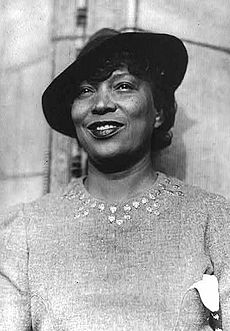
- Andrew Anderson, doctor and St. Augustine mayor
- Steve Berry (novelist), bestselling author
- Richard Boone, actor
- Ray Charles, famous pianist, singer, and composer
- Henry Flagler, industrialist who built railroads and hotels
- Willie Galimore, football star
- Robert Hayling, civil rights leader
- Zora Neale Hurston, novelist and folklorist
- Stetson Kennedy, author and human rights activist
- Pedro Menéndez de Avilés, founder of St. Augustine
- Osceola, Seminole War leader (held prisoner at Fort Marion)
- Marjorie Kinnan Rawlings, novelist
- Marcus Roberts, musician
- Steve Spurrier, American football coach
- David Levy Yulee, first Jewish U.S. Senator
Sister Cities
St. Augustine has sister cities around the world:
 Avilés, Spain
Avilés, Spain Cartagena, Colombia
Cartagena, Colombia Menorca, Spain
Menorca, Spain Santo Domingo, Dominican Republic
Santo Domingo, Dominican Republic
Gallery
-
Bell tower on the northeast side of the Castillo de San Marcos
-
The Government House. Part of the building is from the 18th century.
-
Front of the Roman Catholic Cathedral of St. Augustine
-
Shrine of Our Lady of La Leche at Mission Nombre de Dios
-
Statue of Ponce de León
-
The former Hotel Alcazar now holds the Lightner Museum and City Hall
-
Flagler College, once the Ponce de Leon Hotel
See also
 In Spanish: San Agustín (Florida) para niños
In Spanish: San Agustín (Florida) para niños




